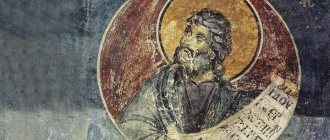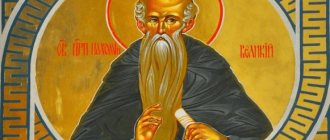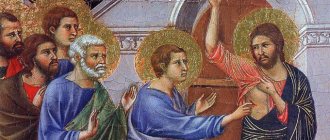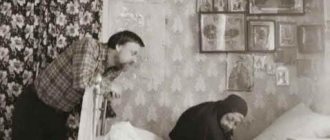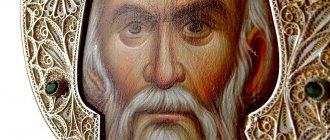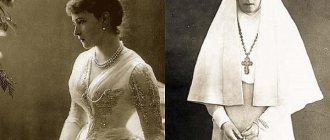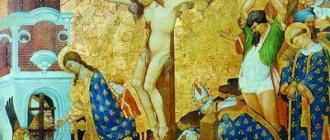The first Russian saints Inna, Pinna and Rimma
On February 2 we honor the first Russian saints: Inna, Pinna and Rimma
Holy martyrs Inno, Pinno and Rimmo, pray to Christ God to save our souls
On February 2, we honor the first Russian saints: Inna, Pinna and Rimma.
The history of the Russian holy martyrs who shed their blood for Christ begins in apostolic times - in those times when the holy Apostle Andrew came to baptize our ancestors with a sermon about salvation.
Saint Rimma
22.07.2013
Rimma Ivanova was the only “ordinary” woman to receive Russia’s highest military award - the Order of St. George, 4th degree. Before her, this honor was awarded to Empress Catherine II and Queen Maria Amalia of the Two Sicilies. In addition, she was awarded the "soldier's" George of the fourth degree and two St. George medals.
On September 22, 1915, the commander of the 31st Army Corps, Adjutant General Mishchenko, whose units were located on the front line in the Minsk region, sends a telegram to the Stavropol governor:
“On September 17, the Emperor deigned to honor the memory of the late sister of mercy Rimma Mikhailovna Ivanova with the Order of St. George, 4th degree. Sister Ivanova, despite the entreaties of the regimental doctor, officers and soldiers, always bandaged the wounded on the front line under terrible fire, and on September 9, when both officers of the 10th company of the 105th Orenburg regiment were killed, she gathered soldiers to her place and, rushing forward together with them, she took enemy trenches. Here she was mortally wounded and died, mourned by officers and soldiers... The corps, with deep grief and condolences, pays respect to the family of the deceased, who raised the heroine - a sister of mercy. What I ask you to inform parents and relatives living on the street. Lermontovskaya, 28".
Soon, the coffin with the body of Rimma Ivanova arrived in her homeland, Stavropol. The whole city came out to bury her. A description of those mourning days has been preserved. In the morning, the soldiers of the units located in Stavropol were deployed from the station along the central street of the city - Nikolaevsky Prospekt. After a short word spoken by Bishop Michael, the coffin with the body of the deceased was placed on a white hearse harnessed to four horses in white blankets. At the front of the procession, Rimma Ivanova’s awards were carried on velvet cushions. At the head of the funeral procession behind the coffin were the Stavropol governor B. Yanushevich, Bishop Mikhail, representatives of the nobility, intelligentsia, merchants, high school students, and students of theological seminary. Next comes a military band and a detachment of troops with a banner and weapons. The funeral procession moved to the sound of the bells of all Stavropol churches. The clergy of churches with banners and icons joined as the procession progressed. The procession stopped at the gymnasium where the girl studied, at her parents’ house. In the Church of St. Apostle Andrew the First-Called, the Divine Liturgy was served by His Eminence Archbishop Agathador.
In his farewell speech, spoken over the grave at the Cathedral of St. Andrew the Apostle the First-Called, Archpriest Semyon Nikolsky said: “France had the Maid of Orleans - Joan of Arc. Russia has a Stavropol maiden - Rimma Ivanova. And her name will henceforth live forever in the kingdoms of the world.”
Rimma Ivanova became the only, let’s say, “ordinary” woman to receive Russia’s highest military award - the Order of St. George, 4th degree. Before her, among the women this honor was awarded to the founder of the order, Empress Catherine II, and later to Queen Maria Amalia of the Two Sicilies. In addition, she was awarded the "soldier's" George of the fourth degree and two St. George medals.
In the same 1915, a feature film was made about the life and feat of Rimma, songs were created, and a record was recorded. A Rimma Ivanova scholarship was established at the Stavropol gymnasium and paramedic school. And all this in honor of a young girl, who was then only twenty-one years old.
What happened on September 9, 1915, when the 105th Orenburg Infantry Regiment attacked the enemy near the village of Dobroslavka, the center of the Dobroslav volost of the Pinsk district of the Minsk province (now the Pinsk district of the Brest region)? And who is she anyway, Rimma Ivanova?
Rimma Ivanova at the gymnasium
Rimma Mikhailovna Ivanova was born on June 15 (27), 1894 in Stavropol in the family of official Mikhail Pavlovich Ivanov and his wife Elena Nikolaevna, née Danishevskaya. The family was very respected in the city. My father was the treasurer of the Stavropol Spiritual Consistory and a collegiate assessor. This is a very small title, in the story by N.V. Gogol’s “nose” is the title of the main character Major Kovalev. By the way, Nikolai Vasilyevich himself rose to this rank. Rimma’s father “for excellent and diligent service and special labors” was awarded the Order of St. Stanislav, 3rd degree and a silver medal in memory of the reign of Alexander the Third. Honest hard-working official!
In 1902, Rimma entered the Olga women's gymnasium. She studied easily, was cheerful and sociable, and quickly became everyone's favorite. They remember such an incident from those years. The schoolchildren were walking near the pond. Suddenly one young man slipped awkwardly on the bridges, fell into the water and began to drown. Rimma threw herself into the water as she was, in her dress and shoes, and saved the drowning man.
In 1913, after graduating from high school, she plans to continue her education and enroll in higher economic courses in St. Petersburg. Her parents persuaded her to postpone the trip for a year. She is too young, inexperienced and fragile for the noisy capital. However, Rimma cannot sit idle and, having received the position of teacher at one of the zemstvo schools, goes to the village of Petrovskoye, Blagodarnensky district. The school did not even have its own premises, but difficulties only strengthened the young teacher. Serving Russia and the people is her main task.
After the end of the school year, Rimma decides to continue her education, but the war with Germany begins. In Stavropol, as if deep in the rear, they began equipping hospitals. Short-term nursing courses open, and Rimma immediately enrolls in them. The decree of the Stavropol provincial zemstvo council of September 7, 1914 has been preserved that Rimma Ivanova was sent as a nurse to hospital No. 2. By the way, among the many girls who followed her example was the daughter of the Stavropol governor Elena Movillo, who would later go to the front as a nurse and will be awarded the soldier's St. George Cross, 4th degree.
The wounded arrived in Stavropol hospitals in an endless stream. Including hospital No. 2, where Rimma worked selflessly. It is difficult to imagine the horrors of war wounds, blood and dirt that passed before the eyes of a fragile and impressionable girl. And, nevertheless, she firmly decided to take one more step - to go to the front herself, to join the active army.
On January 17, 1915, Rimma voluntarily went to the Western Front, to the 83rd Samur Infantry Regiment, which was stationed in Stavropol before the war. Under the name of orderly Ivan Mikhailovich Ivanov, the girl left for the front lines. Only later, having become a sister of mercy, did she find her name - Rimma Mikhailovna Ivanova.
The parents, although they understood their daughter’s patriotic impulse, were horrified by her action. A year ago they didn’t let her into St. Petersburg because of her “fragility and inexperience,” and now their dear child is with the soldiers, in the same gray, dirty overcoat on the front line. Among blood, lice and death.
Sister of Mercy – Rimma Mikhailovna Ivanova
From Rimma Ivanova’s letter to her parents:
“Lord, how I wish you would calm down. It's about time. You should be happy, if you love me, that I managed to get a job and work where I wanted... But I didn’t do this as a joke and not for my own pleasure, but in order to help. Let me be a true sister of mercy. Let me do what is good and what needs to be done. Think as you want, but I give you my word of honor that I would give a lot, a lot in order to alleviate the suffering of those who shed blood. But don’t worry: our dressing station is not under fire... My dears, don’t worry for God’s sake. If you love me, then try to do what is best for me... Then this will be true love for me. Life is generally short, and you need to live it as fully and as best as possible. Help, Lord! Pray for Russia and humanity."
By this time, for her courage and heroism in rescuing the wounded under enemy fire, she had already been awarded the soldier's St. George Cross, 4th degree, and two St. George medals.
In July 1915, yielding to the spells of her parents, especially since her father fell ill, Rimma left the front line on vacation. But she can’t stand it there for long; her soul is on the front line, with her soldiers, who literally idolized Rimma. She again leaves for the front, only meeting her worried parents halfway in one way - she is transferred to the 105th Orenburg Infantry Regiment, where Rimma’s older brother, Vladimir Ivanov, served as the regimental doctor. This is how Rimma Ivanova ends up in Belarus: the 105th Orenburg Regiment then fought in the Polesie sector of the Western Front.
From a letter from Rimma Ivanova in early September 1915:
“My good, dear mom and dad! I feel good here. The people here are very nice. Everyone treats me kindly... God bless you. And for the sake of our happiness, do not be discouraged.”
For her extraordinary courage, when a girl, without waiting for the end of the battle, pulled our soldiers to safety under bullets, she was nicknamed “Saint Rimma.”
From a letter from Rimma Ivanova to her parents on September 8, 1915:
“We feel good! It's calm now. Don't worry, my dear ones. We kiss. Rimma. 8.IX.15.”
The plural is here because the girl reassured her parents on her own behalf and on behalf of her brother, a regimental surgeon.
The next day, September 9, 1915, the 105th Orenburg Infantry Regiment attacked the Germans near the village of Dobroslavka, now the Pinsk district of the Brest region. The Germans met the 10th company with brutal fire; several heavy German Maxim machine guns literally mowed down our infantry. Two officers died, the soldiers wavered, began to retreat, panic began, but then Rimma Ivanova stood up, bandaging the wounded in the thick of the battle. “Forward, follow me!” - the girl shouted and was the first to rush under the bullets. The regiment rushed with bayonets after its favorite and overthrew the enemy. Rimma was mortally wounded by an explosive bullet in the thigh.
According to eyewitnesses, her last words were: “God save Russia.”
Death rushed over the battle amid hellish noise and screaming, looking for more and more victims; Blood flowed like a river, groans, screams and “hurray” merged into a continuous howl. And only Saint Love walked across the field. A woman walked without fear or doubt, bowing to the suffering, and with a gentle hand she hurried to alleviate the great torment, or to escort the sufferer to rest with affection...
These lines about Rimma were written by her colleague, one of the officers of the 105th Orenburg Regiment.
On the initiative of the regiment personnel, a petition was sent to Emperor Nicholas II to award sister of mercy Rimma Ivanova the Order of St. George, 4th degree. In general, this order was purely military, awarded to officers, royalty does not count. Therefore, formally, Nikolai could not award it to a woman, and even a simple sister of mercy. True, such an award in the Patriotic War of 1812 was received by the famous “cavalry maiden” N.A. Durova, about whom the film “The Hussar Ballad” narrates. But she was awarded the order as a man, hiding under the name of cornet Alexandrov. After much deliberation, Emperor Nicholas II signed a personal decree awarding Rimma Ivanova.
The reaction of the “progressive” Western public to the feat of Rimma Ivanova, which thundered throughout the world, is extremely curious. The then chairman of the German Red Cross, General Pfuhl, stated in the press that nurses in battle should follow the Convention on the Neutrality of Medical Personnel, and not perform feats. However, the Geneva headquarters of the International Committee of the Red Cross rejected the German's protest. That is, people without conscience, honor, who have no concept of patriotism and at the same time lecture others, were in the West at that time.
The tombstone of Rimma Ivanova in the fence of the Church of St. Andrew the First-Called
In Soviet times, the name of the national heroine was forgotten. Her burial place was razed to the ground when the cemetery on the territory of St. Andrew's Church was destroyed. But now, in the fence of the Church of St. Andrew the First-Called, a modest tombstone has been installed at the supposed place of her burial. A memorial plaque appeared on the building of the former Olginskaya gymnasium in Stavropol (now a boarding school for deaf-mute children).
It would be nice if a memorial sign were installed at the site of the death of this heroine in Belarus, as a testament to the memory of descendants for such fragile and selfless girls, on whom the world rests.
Vladimir Kazakov
The first Russian martyrs
The first Russian holy martyrs are Inna, Pinna, Rimma, whose memory is celebrated by the Russian Orthodox Church on January 20 / February 2.
As Saint Demetrius of Rostov narrates, on the Kyiv hills the Apostle Andrew, addressing his disciples, said: “Believe me that the grace of God will shine on these mountains; a great city will be here, and the Lord will erect many churches there and enlighten the entire Russian land with holy baptism.”
Disciples of St. Andrew the Apostle
The first Russian holy martyrs Inna, Pinna and Rimma (1st century) were disciples of the holy Apostle Andrew. They were originally from the northern land of Great Scythia, that is, they are Ilmen Slavs-Russians.
Inna, Pinna, Rimma were baptized by the Apostle Andrew, ordained priests and sent to strengthen faith and establish piety among the Greeks and foreigners living in the Bosphorus kingdom. On the way to Tavria, they preached the Christian faith everywhere and baptized the people.
Saint Inna what to pray for
Sunday, February 01, 2015 18:50 + to quote book
The history of the Russian holy martyrs who shed their blood for Christ begins in apostolic times - in those times when the holy Apostle Andrew came to baptize our ancestors with a sermon about salvation. The first Russian holy martyrs are Inna, Pinna, Rimma, whose memory is celebrated by the Russian Orthodox Church on January 20 / February 2.
The first Russian holy martyrs Inna, Pinna and Rimma (1st century) were disciples of the holy Apostle Andrew. They were originally from the northern land of Great Scythia, that is, they are Ilmen Slavs-Russ[2].
Inna, Pinna, Rimma were baptized by the Apostle Andrew, ordained priests and sent to strengthen faith and establish piety among the Greeks and foreigners living in the Bosphorus kingdom. On the way to Tavria, they preached the Christian faith everywhere and baptized the people.
Among the first Russian saints, the holy martyrs of Chersonesos are also known: bishops Basil, Ephraim, Eugene, Agathador, Elpidius, Epherius, Kapito, the holy martyr Emilian, the holy great martyr Nikita Stratilates of Scyphogoth († 305), the holy martyr Florian Stratilates († 300).
This is only a small part of the famous first Russian saints glorified by the Ecumenical Orthodox Church. And how much information has been lost about other Slavic-Russian saints! The chronicles, which contained so much valuable information about the lives of our distant ancestors, perished in the fire of invasions of foreigners: the Goths, Huns, Khazars and others.
Unfortunately, in liturgical practice the memory of the holy martyrs Inna, Pinna and Rimma is not expressed in a special service, therefore among church people the day of their memory is completely and unjustifiably forgotten. The glorification of the memory of the first Russian saints should become a stable liturgical tradition for our holy Church and should be elevated to the type of statutory service, at least to the polyeleos service.
Glorifying the first national saints and praying to them is our duty and honor. The holy martyrs Inna, Pinna and Rimma are the first sacred gift, the first fruit of the faith of our distant ancestors, which they brought as a sign of their faith and love for our Lord and Savior Jesus Christ, opening with their first martyrdom the beginning of the collection of a precious spiritual treasury - the great host of all saints who shone in the Russian land.
[4] See: Sergius (Spassky), Archbishop. Complete monthly books of the East: In 3 volumes. M., 1997 (Rep. ed. 1901). T. 2. P. 19. Archbishop Philaret (Gumilevsky), referring to the works of Blessed Jerome, expressed the opinion that the holy martyrs Tirsus, Kyriakos, Hellinikos are the baptismal names of saints Inna, Pinna and Rimma. However, according to modern studies of martyrological lists and comments by I. Delee to the Martyrology, the martyr Kyriakos suffered in Nicomedia, and the martyrs Thirsus and Hellinikos - in Bithynia in the middle of the 3rd century. (ActaSS. Nov. T. 2. Pars 2. P. 50–52) - see: Orthodox Encyclopedia. T. 22. P. 680.
[6] Asta Sanctorum. Januariis 20. 1643. Tom. 2. P. 297. We express our gratitude to Irina Vladimirovna Kuvshinskaya, senior lecturer of the Department of Ancient Languages, Faculty of History, Moscow State University, for translating the document into Russian.
[10] Tatishchev V.N. From the Scythians to the Slavs: Russian history in its entirety. M., 2011. P. 54.
The custom-made icon of St. Inna of Novodun is an original handwritten work made taking into account all your wishes. We will take into account any of your ideas and clarifications to the image that do not contradict the Orthodox canon. First of all, you need to choose an image from a photograph that is most spiritually close to you. Look at our samples or attach any photo from the Internet. Further, the type of execution, only a gold halo, a gold field background and a halo, or a double gilding technique with jewelry engraving of the ornament. Select the size and submit the order. Our Icon Architect will call you almost immediately and discuss the composition of the image with you.
Our workshop was founded at the Temple. Icons are painted according to the Blessing by church-going icon painters, strictly observing Orthodox traditions and the canon. The execution time is on average from 14 days to 3 months, depending on the complexity of the execution. But it can happen faster or longer. You can order the icon of Saint Inna of Novodun by clicking the Order button, and if you are too lazy, write to us by email or feel free to call us. WhatsApp also works 24/7.
For home storage and durability of the icon, we highly recommend purchasing an icon case. An icon case made of natural wood protects the image from seasonal changes in temperature, humidity, and dust. More details
Inna Novodunsky is a Christian saint, a Slav who lived in the 1st-2nd century in Scythia Minor (the Black Sea coast south of the Danube, including Romania and Bulgaria, as well as the territory of modern Crimea) and was a disciple of the holy Apostle Andrew the First-Called.
Together with Inna Novodunsky, the disciples of the Apostle Andrew were also the young men Pinna and Rimma (initially all these three names were male). All of them were constant companions of the Apostle Andrew for many years. All three became famous for spreading Christian teaching throughout pagan Scythia and accepting martyrdom for Christ. In the cold winter, the infidels tied them to poles and left them to die.
These saints are especially revered in Crimea, where a small chapel was erected in their honor and their holy relics are kept.
Celebrations in honor of Inna Novodunsky take place in the Orthodox Church twice a year:
An icon depicting the martyr Inna Novodunsky is a great rarity in Christian churches. One of the few can be found in Crimea in the chapel erected in honor of Saints Inna, Pinna and Rimma of Novodunsky. It is located in Alushta near the Church of All Saints.
The relics of the saint and his brothers in Christ Pinna and Rimma are located in Alushta in Crimea in an ancient chapel erected in honor of the three holy martyrs.
They pray to Saints Inna, Pinna and Rimma of Novodunsky for protection and patronage during severe frosts, to survive cold and hungry winters. They also ask them for healing for various frostbites.
These saints are also revered as the heavenly patrons of modern Crimea.
Just as the First-Called disciples of the first calling appeared from the words, and enlightened your brethren with the light of Truth, from the godless, fierce prince they met a cruel death of nature, bound by filth and strangled by ice, on the Danube River in the Scythian country. But as you laid down your souls for others, Saints Inno, Pinno and Rimmo, bring all-powerful prayers for us, turning all the Slovenian languages back to Christ.
The great faith of correction: encased in ice, as if on the water of repose, Saints Inna, Pinna and Rimma rejoiced, while the tormentor senselessly rages, trying to destroy the fruits of their grapes, but still to this day Christ receives the holy clusters from the Slovenian language, and the first martyr of the Slovenians crowns the crowns. For this reason, we, the faithful children you raised, thank you and pray, you saints: ask with warm prayers and for us in the Spirit of truth to be zealous for God.
Unfortunately, very little information has reached us about the life of Saint Inna of Novodun. It is known that Saint Inna, together with his friends Pinna and Rimma, were Slavic youths who lived in the 1st-2nd century in Scythia Minor.
All of them were disciples of the holy Apostle Andrew the First-Called, who in those days preached Christian teaching among the Slavic peoples. It was the holy Apostle Andrew who converted the young men to the Christian faith and blessed them for further preaching. Inna, Pinna and Rimma spread the teachings of Jesus Christ throughout Scythia Minor and baptized a large number of people there.
One day the local pagan ruler found out about this. Being very angry, he ordered the young men to be seized and all three brought to his palace. At first, young Christians were persuaded to renounce the Christian faith and perform pagan sacrifices. Having achieved nothing, the angry ruler ordered the rebellious Christians to be tortured.
This all happened in winter, when the rivers were so frozen that it was possible to move along them without hindrance even on horse-drawn carts. Large wooden stakes were driven into the river ice, to which three scantily clad young men were tied. Left like this in the bitter cold, they died, betraying their souls to the Lord God.
Inna, Pinna and Rimma were buried not far from the place of their execution. However, a few months later, by order of Bishop Godd, their relics were transferred and buried in one small church. And seven years later, Saints Inna, Pinna and Rimma appeared to the bishop in a subtle dream and asked him to transfer their relics to the sea pier of the village of Alix (modern Alushta, Crimea).
Soon, at the site of their reburial, a small chapel was erected in honor of Saints Inna, Pinna and Rimma, which exists to this day.
There are saints after whom only girls are named - these are the martyrs Inna and Rimma. If you call a girl a man's name, will she have a difficult fate?
Is it true that if you call a girl a man's name, she will have a difficult fate? Archpriest Andrei Efanov comments.
Archpriest Andrey Efanov
No that's not true. I have a parishioner, Rimma (a man’s name, by the way). Both she and her husband lived a wonderful life, and their daughter is a deeply religious person. Life may not be so easy, but it is no different from others.
You should not look for some kind of mysticism in the name. Let's remember the Old Testament - most of the historical figures of Israel were named after certain events in the lives of their parents, for example, Isaac (laughter) was named so because his mother Sarah expected ridicule from her fellow tribesmen, and Jacob (heel) - because he was born clutching his twin brother's leg.
In Christian times, names also most often expressed the dreams of parents about their children. And only later children began to be named in honor of the saints of the Church. But even at the same time, no mystical significance was attached to this phenomenon. That is why Saint Philaret of Moscow allowed changing the name of a child if it was dissonant.
That’s why they don’t call girls by male names and boys by female names, because it’s simply dissonant, unusual, and simply ugly. It is unnatural to name a girl Andrei, Maxima or Nikolai. And it’s not good for a boy to be called Vasilis or Xen (in honor of Saint Xenia). But there are names that are equally beautiful in both masculine and feminine gender: Seraphim-Seraphim, Alexander-Alexandra, Afanasy-Afanasia.
Most often, it is customary to name children in honor of saints of the same gender as the child. But there are also exceptions. Quite a few girls were named in honor of St. Seraphim of Sarov. And there are saints in whose honor only girls are named - these are the martyrs Inna and Rimma. In modern Russian, the names of these saints have acquired a pronounced feminine gender.
And numerous Inns and Rimmas have lived in Russia from time immemorial, without complaining about their fate and the fact that their patrons are holy men. After all, this does not matter at all, since in Christ gender differences are unimportant (Gal. 3:29).
Photo: juliastar, photosight.ru
Inns and Rimmas are different, their destinies are different.
“Lord, how I wish you would calm down. It's about time. You should be happy, if you love me, that I managed to get a job and work where I wanted... But I didn’t do this as a joke and not for my own pleasure, but in order to help. Let me be a true sister of mercy. Let me do what is good and what needs to be done. Think as you want, but I give you my word of honor that I would give a lot, a lot in order to alleviate the suffering of those who shed blood.
Rimma Mikhailovna Ivanova was born on June 15, 1894 in the family of the treasurer of a spiritual consistory. She graduated from the gymnasium and began working as a public teacher in the zemstvo school in the village of Petrovskoye.
With the outbreak of the First World War, she returned to Stavropol and, like thousands of other Russian young ladies, completed courses for nurses, after which she worked in the diocesan infirmary for wounded soldiers.
But this was not enough for Rimma. And on January 17, 1915, she cut her hair short and called herself a man’s name and volunteered for the front. She served in the 83rd Samur Infantry Regiment, and when everything was revealed, she began to serve under her real name. For her courage in rescuing the wounded, she was awarded the St. George Cross, 4th degree, and two St. George medals.
In August 1915, Rimma went on a visit to her seriously ill father. He made her promise to transfer to the 105th Orenburg Infantry Regiment, whose regimental doctor was the girl’s older brother, Vladimir Ivanov.
And a month later, the 105th Orenburg Infantry Regiment attacked the enemy near the Belarusian village of Dobroslavka. The Germans met the 10th company with brutal fire. Two officers died, the soldiers wavered and became confused, but then Rimma Ivanova came forward, bandaging the wounded in the thick of the battle.
The 21-year-old sister of mercy Rimma Mikhailovna Ivanova, who died on Belarusian soil, became the only woman in Russia awarded the Order of St. George, 4th degree, the most honorable military award of the Russian army.
“Churikova is a great actress, the same one that our classic Ostrovsky dreamed of, saying that give me such an actress, and I will create a theater. Indeed, if there were a great actress, then the drama theater would exist. An actress is the main profession in the theater, and I am grateful to fate that I had the good fortune to work with such an artist as Churikova. The roles that Inna Mikhailovna created in theater and cinema are sufficient to become a noticeable phenomenon in Russian culture,” admitted Mark Zakharov, artistic director of the Lenkom Theater.
Inna Mikhailovna Churikova was born on October 5, 1943 in the city of Belebey (now in Bashkortostan) into a family of agronomists.
The title of People's Artist of the USSR, the State Prize of the Russian Federation, two Orders of Merit for the Fatherland, many cinematic, television and theater awards, almost four dozen films in her filmography - the talent of the great actress Inna Churikova was appreciated by both the state and the audience.
Have you read the article Inna and Rimma - Orthodox male names?
Martyrdom of the Saints
By order of the pagan prince of Chersonesos, they were captured and given a terrible execution for preaching Christians. In the Western church hagiographical tradition, evidence has been preserved in the “Asta Sanctorum” of Jacob of Voraginsky about their martyrdom: May the purest, like crystal, warriors of cold, Inna, Pinna, Rimma, find warmth. They suffered martyrdom in a certain northern province, where they were captured by idolatrous barbarians and brought before the ruler. He commanded that the confessors of Christ should die from the cold. The martyrs were tied to straight and solid logs installed in the middle of the stream, and although it was a windy and cold season and the hard surface of the water was frozen, they remained motionless until they reached the limit of earthly life, betraying their blessed souls into the hands of God.”
Thus, the saints gave up their righteous souls to God, preserving the pledge of faith and love for our Lord and Savior Jesus Christ, glorifying Him with their martyrdom. Christians secretly buried the bodies of God's saints.
LiveInternetLiveInternet
Nikolay Solntsev
The history of the Russian holy martyrs who shed their blood for Christ begins in apostolic times - in those times when the holy Apostle Andrew came to baptize our ancestors with a sermon about salvation. The first Russian holy martyrs are Inna, Pinna, Rimma, whose memory is celebrated by the Russian Orthodox Church on January 20 / February 2.
/www.pravoslavie.ru/sas/image/video/zoom.gif" target="_blank">https://www.pravoslavie.ru/sas/image/video/zoom.gif) no-repeat;" title=”St. Euthymius the Great, St. Inna, Pimma and Rimma, martyr. (January 20th). Menology of Byzantium. Greece; XIV century.">St. Euthymius the Great, St. Inna, Pimma and Rimma, martyr. (January 20th). Menology of Byzantium. Greece; XIV century As St. Demetrius of Rostov, who compiled the famous Chetyi-Menaia, narrates, on the Kyiv hills Apostle Andrew, addressing his disciples, said: “Believe me that the grace of God will shine on these mountains; a great city will be here, and the Lord will erect many churches there and enlighten the entire Russian land with holy baptism”[1].
The first Russian holy martyrs Inna, Pinna and Rimma (1st century) were disciples of the holy Apostle Andrew. They were originally from the northern land of Great Scythia, that is, they are Ilmen Slavs-Russ[2].
In the book of Archbishop Sergius (Spassky) “The Complete Monthly Book of the East”, Scythia Minor is mistakenly named as their homeland. “The Roman and early Byzantine province of Scythia Minor (the region of modern Dobrudja, Romania) appeared only at the end of the 3rd - beginning of the 4th century AD under the emperor Diocletian” [3], so it is impossible to simultaneously be students of the Apostle Andrew and residents of Scythia Minor, which I did not pay attention to Archbishop Sergius[4].
Inna, Pinna, Rimma were baptized by the Apostle Andrew, ordained priests and sent to strengthen faith and establish piety among the Greeks and foreigners living in the Bosphorus kingdom. On the way to Tavria, they preached the Christian faith everywhere and baptized the people.
By order of the pagan prince of Chersonesos, they were captured and given a terrible execution for preaching Christians. In the Western church hagiographical tradition, evidence of their martyrdom has been preserved in the “Asta Sanctorum” of James of Voragines[5]:
| «De Sanctis Martyribus Inna, Pinna, Rimma. | «About the holy martyrs Inna, Pinna, Rimma. |
| Non sit calidum et splendidus sicut crystallus Inna refrigerandi vim habet ad fortes illius, Pinnensem Rima. Et in agonibus martyrum, quaedam prouinciae conuenerunt, et idolis servientes, quo capta barbaros ad praesidem. Christus praecepit ut a frigus confessoris. Martyr accideret structum solidus acta in medio aquarum: et quamvis per ventosa frigoribus et corpus aquae gelu constricti et sedebam tristis usque peruenit ultimum vita, operam ad eorum beatitudinis rutsi anima Dei.” | May the warriors of cold, Inna, Pinna, and Rimma, as pure as crystal, find warmth. They suffered martyrdom in a certain northern province, where they were captured by idolatrous barbarians and brought before the ruler. He commanded that the confessors of Christ should die from the cold. The martyrs were tied to straight and solid logs installed in the middle of the stream, and although it was a windy and cold season and the hard surface of the water was frozen, they remained motionless until they reached the limit of earthly life, betraying their blessed souls into the hands of God.”[6 ]. |
Chapel in honor of the holy martyrs Inna, Rimma and Pinna in Alushta
Thus, the saints gave up their righteous souls to God, preserving the pledge of faith and love for our Lord and Savior Jesus Christ, glorifying Him with their martyrdom. Christians secretly buried the bodies of God's saints. When a favorable time for Christians arrived in the city, Bishop Gedtsa, who ruled the local diocese, found the holy relics and placed them in the reliquary of the city’s cathedral church. Seven years later, the martyrs appeared to the bishop and ordered him to transfer their holy relics to a “dry harbor” - a place called Alix (now this place is called Alushta).
“The original text of the manuscript of the Martyrdom (probably the second half of the 4th century) has not survived; a manuscript of the 11th century (Paris. Gr. 1488) contains a brief extract from it (epithome); legends are also known in the Byzantine verse synaxarions of the late X - XIII centuries (see, for example: SynCP. Col. 407; Paris. Gr. 1617; Ambros. B. 104) <…> The title of the epitome indicates that Inna, Pinna , Rimma suffered in Gothia (in the Minology of Emperor Basil II (late 10th - early 11th centuries) the archaic name is used - Scythia. <...> Prof. E.E. Golubinsky suggested that Inna, Pinna and Rimma suffered in the Crimea , and their relics were transferred to the port of Alisk or Alix, which was located on the site of modern Alushta”[7].
It can be assumed that the holy martyrs Inna, Pinna, Rimma had the rank of bishops, since the kontakion (hymn) dedicated to them says: “... Christian intercessors, evangelists of the Kingdom of God,” and such a comparison is applicable only to bishops. “Rejoice, saints Inna, Pinna and Rimma, passion-bearers of Christ and the first Baptists (!) and Heavenly intercessors of the Russian Land...”[8]
In the “Complete Monthly Book of the East,” Archbishop Sergius (Spassky) cites information from the Serbian prologue of the 13th century, where in the teaching for the day of remembrance of the holy Russian martyrs, their names are given in the Serbian vowel: Enen, Nirin and Pen[9].
Among the Russian saints of the 1st century, V.N. Tatishchev names the unjustifiably forgotten prince martyr Oskold (Askold) and Gleb (Uleb), brother of Svyatoslav. He wrote: “He (Oskold) can be revered as the first martyr in Rus', just like Uleb (Gleb), the brother of Svyatoslav, who, due to ignorance of history, are forgotten and are not included in the calendar.”[10].
Among the first Russian saints, the holy martyrs of Chersonesos are also known: bishops Basil, Ephraim, Eugene, Agathador, Elpidius, Epherius, Kapito, the holy martyr Emilian, the holy great martyr Nikita Stratilates of Scyphogoth († 305), the holy martyr Florian Stratilates († 300).
This is only a small part of the famous first Russian saints glorified by the Ecumenical Orthodox Church. And how much information has been lost about other Slavic-Russian saints! The chronicles, which contained so much valuable information about the lives of our distant ancestors, perished in the fire of invasions of foreigners: the Goths, Huns, Khazars and others.
Miniature minology of Vasily II
In the archives of Simferopol there is a document entitled “To all priests of the Simferopol and Crimean diocese”: “I ask you, all-honorable fathers, to remember the holy martyrs Inna, Pinna, Rimma at the liberation liturgy, vespers and matins, for they should be considered Crimean saints. These are very ancient martyrs.” This document was signed on October 30, 1950 by Saint Luke (Voino-Yasenetsky), Archbishop of Simferopol and Crimea. Now, near the Alushta temple in the name of All Crimean Saints, a chapel of the holy martyrs Inna, Pinna, Rimma has been erected, where a rare icon with their holy images is placed on the wall.
Unfortunately, in liturgical practice the memory of the holy martyrs Inna, Pinna and Rimma is not expressed in a special service, therefore among church people the day of their memory is completely and unjustifiably forgotten. The glorification of the memory of the first Russian saints should become a stable liturgical tradition for our holy Church and should be elevated to the type of statutory service, at least to the polyeleos service.
Glorifying the first national saints and praying to them is our duty and honor. The holy martyrs Inna, Pinna and Rimma are the first sacred gift, the first fruit of the faith of our distant ancestors, which they brought as a sign of their faith and love for our Lord and Savior Jesus Christ, opening with their first martyrdom the beginning of the collection of a precious spiritual treasury - the great host of all saints who shone in the Russian land.
Discovery of relics and posthumous glory
When a favorable time for Christians arrived in the city, Bishop Gedtsa, who ruled the local diocese, found the holy relics and placed them in the reliquary of the city’s cathedral church. Seven years later, the martyrs appeared to the bishop and ordered him to transfer their holy relics to a “dry harbor” - a place called Alix (now this place is called Alushta).
Saint Luke about the martyrs Inna, Pinna and Rimma
In the archives of Simferopol there is a document entitled “To all priests of the Simferopol and Crimean diocese”: “I ask you, all-honorable fathers, to remember the holy martyrs Inna, Pinna, Rimma at the liberation liturgy, vespers and matins, for they should be considered Crimean saints. These are very ancient martyrs.” This document was signed on October 30, 1950 by Saint Luke (Voino-Yasenetsky), Archbishop of Simferopol and Crimea. Now, near the Alushta temple in the name of All Crimean Saints, a chapel of the holy martyrs Inna, Pinna, Rimma has been erected, where a rare icon with their holy images is placed on the wall.
Author:
Tatiana
We publish in the telegram earlier than on the website. Subscribe to the Pravlife Channel
Inna and Rimma - names of Orthodox saints
Is it true that if you call a girl a man's name, she will have a difficult fate? Comments.
No that's not true. I have a parishioner, Rimma (a man’s name, by the way). Both she and her husband lived a wonderful life, and their daughter is a deeply religious person. Life may not be so easy, but it is no different from others.
You should not look for some kind of mysticism in the name. Let's remember the Old Testament - most of the historical figures of Israel were named after certain events in the lives of their parents, for example, Isaac (laughter) was named so because his mother Sarah expected ridicule from her fellow tribesmen, and Jacob (heel) - because he was born clutching his twin brother's leg.
In Christian times, names also most often expressed the dreams of parents about their children. And only later children began to be named in honor of the saints of the Church. But even at the same time, no mystical significance was attached to this phenomenon. That is why he allowed the child’s name to be changed if it was dissonant.
That’s why they don’t call girls by male names and boys by female names, because it’s simply dissonant, unusual, and simply ugly. It is unnatural to name a girl Andrei, Maxima or Nikolai. And it’s not good for a boy to be called Vasilis or Xen (in honor of). But there are names that are equally beautiful in both masculine and feminine gender: Seraphim-Seraphim, Alexander-Alexandra, Afanasy-Afanasia.
Most often, it is customary to name children in honor of saints of the same gender as the child. But there are also exceptions. Quite a few girls have been named in honor. And there are saints in whose honor only girls are named - these are the martyrs Inna and Rimma. In modern Russian, the names of these saints have acquired a pronounced feminine gender.
And numerous Inns and Rimmas have lived in Russia from time immemorial, without complaining about their fate and the fact that their patrons are holy men. After all, this does not matter at all, since in Christ gender differences are unimportant (Gal. 3:29).
Inns and Rimmas are different, their destinies are different.
